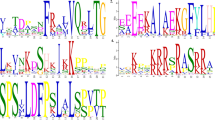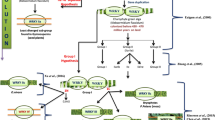Abstract
MADS box genes code for a large family of transcription factors which regulate development in higher plants, notably flower formation. We describe here a study of members of the MADS box gene family in oil palm (Elaeis guineensis Jacq.), a representative of the family Arecaceae and order Arecales, a key group of monocotyledons which has been unreported in previous phylogenetic reconstructions of the different recognized clades of MADS box genes. In this study, 13 oil palm MADS box genes were identified and characterized. They were found to belong to five different subfamilies, namely, the previously defined SQUAMOSA, AGAMOUS, AGAMOUS-like2, DEFICIENS, and GLOBOSA groups. Genes belonging to each of these groups play a critical role in the determination of flower structure as defined by the ABCDE model. The in planta expression profiles of the oil palm MADS box genes were studied by RT-PCR and phylogenetic sequence diversity within individual subfamilies was investigated by comparing their deduced protein sequences with those of other angiosperms. Most of the oil palm sequences studied were observed to group with distinct supported clades within their subfamily. Some unexpected groupings were observed between monocot sequences (including oil palm ones) of non-Poaceae origin, probably illustrating the importance of obtaining adequate taxon representation in monocot molecular phylogenies.






Similar content being viewed by others
References
Adam H, Jouannic S, Escoute J, Duval Y, Verdeil JL, Tregear JW (2005) Reproductive developmental complexity in the African oil palm (Elaeis guineensis). Am J Bot 92:1836–1852
Ainsworth C, Crossley S, Buchanan-Wollaston V, Thangavelu M, Parker J (1995) Male and female flowers of the dioecious plant sorrel show different patterns of MADS box gene expression. Plant Cell 7:1583–1598
Altschul SF, Gish W, Miller W, Myers EW, Lipman DJ (1990) Basic local alignment search tool. J Mol Biol 215:403–410
Alvarez-Buylla ER, Pelaz S, Liljegren SJ, Gold SE, Burgeff C, Ditta GS, Ribas de Pouplana L, Martinez-Castilla L, Yanofsky MF (2000) An ancestral MADS-box gene duplication occurred before the divergence of plants and animals. Proc Natl Acad Sci USA 97:5328–5333
Ambrose BA, Lerner DR, Ciceri P, Padilla CM, Yanofsky MF, Schmidt RJ (2000) Molecular and genetic analyses of the SILKY1 gene reveal conservation in floral organ specification between eudicots and monocots. Mol Cell 5:569–579
Angenent GC, Colombo L (1996) Molecular control of ovule development. Trends Plant Sci 1:228–232
Becker A, Theissen G (2003) The major clades of MADS-box genes and their role in the development and evolution of flowering plants. Mol Phylogenet Evol 29:464–489
Becker A, Winter KU, Meyer B, Saedler H, Theissen G (2000) MADS-box gene diversity in seed plants 300 million years ago. Mol Biol Evol 17:1425–1434
Becker A, Kaufmann K, Freialdenhoven A, Vincent C, Li MA, Saedler H, Theissen G (2002) A novel MADS-box gene subfamily with a sister-group relationship to class B floral homeotic genes. Mol Genet Genomics 266:942–950
Chase MW, Fay MF, Devey DS, Maurin O, Ronsted N, Davies J, Pillon Y, Petersen G, Seberg O, Tamura MN, Asmussen CB, Hilu K, Borsch T, Davis JI, Stevenson DW, Pires JC, Givnish TJ, Sytsma KJ, McPherson MM, Graham SW, Rai HS (2005) Mutigene analyses of monocot relationships: a summary. In: Proceedings of Monocots III: Third International Conference on the Comparative Biology and Fourth International Symposium on Grass Systematics and Evolution, Ontario, 2003(in press)
Coen ES, Meyerowitz EM (1991) The war of the whorls: genetic interactions controlling flower development. Nature 353:31–37
Colombo L, Franken J, Koetje E, van Went J, Dons HJ, Angenent GC, van Tunen AJ (1995) The petunia MADS box gene FBP11 determines ovule identity. Plant Cell 7:1859–1868
Corre F, Henry Y, Rode A, Hartmann C (1996) Em gene expression during somatic embryogenesis in the monocot Triticum aestivum L. Plant Sci 117:139–149
Cruden RW (1988) Temporal doecism: systematic breath, associated traits and temporal patterns. Bot Gaz 199:1–15
Dransfield J, Uhl NW, Asmussen CB, Baker WJ, Harley MM, Lewis CE (2005) An outline of a new phylogenetic classification of the palm family, Arecaceae. Kew Bull (in press)
Favaro R, Pinyopich A, Battaglia R, Kooiker M, Borghi L, Ditta G, Yanofsky MF, Kater MM, Colombo L (2003) MADS-box protein complexes control carpel and ovule development in Arabidopsis. Plant Cell 15:2603–2611
Felsenstein J (1985) Confidence limits on phylogenies: an approach using bootstrap. Evolution 39:783–791
Ferrandiz C, Gu Q, Martienssen R, Yanofsky MF (2000) Redundant regulation of meristem identity and plant architecture by FRUITFULL, APETALA1 and CAULIFLOWER. Development 127:725–734
Goremykin VV, Hirsch-Ernst KI, Wölfl S, Hellwig FH (2003) Analysis of the Amborella trichopoda chloroplast genome sequence suggests that Amborella is not a basal angiosperm. Mol Biol Evol 20:1499–1505
Goremykin VV, Hirsch-Ernst KI, Wölfl S, Hellwig FH (2004) The chloroplast genome of Nymphaea alba: whole-genome analyses and the problem of identifying the most basal angiosperm. Mol Biol Evol 21:1445–1454
Goto K, Meyerowitz EM (1994) Function and regulation of the A. thaliana floral homeotic gene PISTILLATA. Genes Dev 8:1548–1560
Guindon S, Gascuel O, (2003) A simple, fast, and accurate algorithm to estimate large phylogenies by maximum likelihood. Syst Biol 52:696–704
Hardenack S, Ye D, Saedler H, Grant S (1994) Comparison of MADS box gene expression in developing male and female flowers of the dioecious plant white campion. Plant Cell 6:1775–1787
Hartley CWS (1988) The oil palm. Tropical Agriculture Series. Longman, London
Honma T, Goto K (2001) Complexes of MADS-box proteins are sufficient to convert leaves into floral organs. Nature 409:525–529
Jack T, Brockman LL, Meyerowitz EM (1992) The homeotic gene APETALA3 of A. thaliana encodes a MADS box and its expressed in petals and stamens. Cell 68:683–697
Johansen B, Pedersen L.B, Skipper M, Frederiksen S (2002) MADS-box gene evolution-structure and transcription patterns. Mol Phylogenet Evol 23:458–480
Kang HG, Jeon JS, Lee S, An G (1998) Identification of class B and class C floral organ identity genes from rice plants. Plant Mol Biol 38:1021–1029
Kramer EM, Dorit RL, Irish VF (1998) Molecular evolution of genes controlling petal and stamen development: duplication and divergence within the APETALA3 and PISTILLATA MADS-box gene lineages. Genetics 149:765–783
Kramer EM, Jaramillo Ma, Di Stilio VS (2004) Patterns of gene duplication and functional evolution during the diversification of the AGAMOUS subfamily of MADS box genes in angiosperms. Genetics 166:1011–1023
Kyozuka J, Kobayashi T, Morita M, Shimamoto K (2000) Spatially and temporally regulated expression of rice MADS box genes with similarity to A. thaliana class A, B and C genes. Plant Cell Physiol 41:710–718
Li QZ, Li XG, Bai SN, Lu WL, Zhang XS (2002) Isolation of HAG1 and its regulation by plant hormones during in vitro floral organogenesis in Hyacinthus orientalis L. Planta 5:533–540
Litt A, Irish VF (2003) Duplication and diversification in the APETALA1/FRUITFULL floral homeotic gene lineage: implications for the evolution of floral development. Genetics 165:821–833
Malcomber ST, Kellog EA (2004) Heterogeneous expression patterns and separate roles of the SEPALLATA gene LEAFY HULL STERILE1 in grasses. Plant Cell 16:1692–1706
Mandel MA, Yanofsky MF (1998) The A. thaliana AGL9 MADS box gene is expressed in young flower primordia. Sex Plant Reprod 11:22–28
Mandel MA, Gustafson-Brown C, Savidge B, Yanofsky MF (1992) Molecular characterization of the A thaliana floral homeotic gene APETALA1. Nature 360:273–277
Münster T, Pahnke J, Di Rosa A, Kim JT, Martin W, Saedler H, Theissen G (1997) Floral homeotic genes were recruited from homologous MADS-box genes preexisting in the common ancestor of ferns and seed plants. Proc Natl Acad Sci USA 94:2415–2420
Münster T, Wingen LU, Faigl W, Werth S, Saedler H, Theissen G (2001) Characterization of three GLOBOSA-like MADS-box genes from maize: evidence for ancient paralogy in one class of floral homeotic B-function genes of grasses. Gene 262:1–13
Nagasawa N, Miyoshi M, Sano Y, Satoh H, Hirano H, Sakai H, Nagato Y (2003) SUPERWOMAN1 and DROOPING LEAF genes control floral organ identity in rice. Development. 130:705–718
Parenicova L, de Folter S, Kieffer M, Horner DS, Favalli C, Busscher J, Cook HE, Ingram RM, Kater MM, Davies B, Angenent GC, Colombo L (2003) Molecular and phylogenetic analyses of the complete MADS-box transcription factor family in A. thaliana: new openings to the MADS world. Plant Cell 15:1538–1551
Pelaz S, Ditta GS, Baumann E, Wisman E, Yanofsky MF (2000) B and C floral organ identity functions require SEPALLATA MADS-box genes. Nature 405:200–202
Pinyopich A, Ditta GS, Savidge B, Liljegren SJ, Baumann E, Wisman E, Yanofsky MF (2003) Assessing the redundancy of MADS-box genes during carpel and ovule development. Nature 424:85–88
Prasad K, Vijayraghavan U (2003) Double-stranded RNA interference of a rice PI/GLO paralog, OsMADS2, uncovers its second-whorl-specific function in floral organ patterning. Genetics 165:2301–2305
Rounsley SD, Gary SD, Yanofsky MF (1995) Diverse roles for MADS box genes in A. thaliana development. Plant Cell 7:1259–1269
Saitou N, Nei M (1987) The neighbor-joining method: A new method for reconstruction phylogenetic trees. Mol Biol Evol 4:406–425
Savolainen V, Chase MW (2003) A decade of progress in plant molecular phylogenetics. Trends Genet 19:717–724
Schwarz-Sommer Z, Huijser P, Nacken W, Saedler H, Sommer H (1990) Genetic control of flower development by homeotic genes in Antirrhinum majus. Science 250:931–936
Soltis DE, Albert VA, Savolainen V, Hilu K, Qiu Y-L, Chase MW, Farris JS, Palmer JD, Soltis PS (2004) Angiosperm relationships, genome-scale data, and “ending incongruence”: a cautionary tale in phylogenetics. Trends Plant Sci 9:478–483
Swofford DL (1999) PAUP* : Phylogenetic analysis using parsimony (*and other methods). Sinauer Associates, Sunderland, MA
Theissen G (2001) Development of floral organ identity: stories from the MADS house. Curr Opin Plant Biol 4:75–85
Theissen G, Becker A, Di Rosa A, Kanno A, Kim JT, Münster K, Winter U, Saedler H (2000) A short history of MADS box genes in plants. Plant Mol Biol 42:115–149
Thompson JD, Gibson TJ, Plewniak F, Jeanmougin F, Higgins DG (1997) The ClustalX windows interface: flexible strategies for multiple sequence alignment aided by quality analysis tools. Nucleic Acids Res 24:4876–4882
Tzeng TY, Chen HY, Yang CH (2002) Ectopic expression of carpel-specific MADS box genes from lily and lisianthus causes similar homeotic conversion of sepal and petal in A. thaliana. Plant Physiol 130:1827–1836
Vandenbussche M, Theissen G, van de Peer Y, Gerats T (2003) Structural diversification and neo-functionalization during floral MADS-box gene evolution by C-terminal frameshift mutations. Nucleic Acids Res 31:4401–4409
Winter KU, Weiser C, Kaufmann K, Bohne A, Kirchner C, Kanno A, Saedler H, Theissen G (2002) Evolution of class B floral homeotic proteins: obligate heterodimerization originated from homodimerization. Mol Biol Evol 19:587–596
Xiao H, Wang Y, Liu D, Wang W, Li X, Zhao X, Xu J, Zhai W, Zhu L (2003) Functional analysis of the rice AP3 homologue OsMADS16 by RNA interference. Plant Mol Biol 52:957–966
Yalovsky S, Rodriguez-Concepcion M, Bracha K, Toledo-Ortiz G, Gruissem W (2000) Prenylation of the floral transcription factor APETALA1 modulates its function. Plant Cell 12:1257–1266
Yanofsky MF, Ma H, Bowman JL, Drews GN, Feldmann KA, Meyerowitz EM (1990) The protein encoded by the A. thaliana homeotic gene AGAMOUS resembles transcription factors. Nature 346:35–39
Zahn LM, Leebens-Mack JH, dePamphilis CW, Ma H, Theissen G (2005a) To B or not to B a flower: the role of DEFICIENS and GLOBOSA orthologs in the evolution of the angiosperms. J Hered 96:225–240
Zahn LM, Kong H, Leebens-Mack JH, Kim S, Soltis PS, Landherr LL, Soltis DE, dePamphilis CW, Ma H (2005b) The evolution of the SEPALLATA subfamily of MADS-box genes. A preangiosperm origin with multiple duplications throughout angiosperm history. Genetics 169:2209–2223
Acknowledgments
The authors are indebted to CNRA (Côte d’Ivoire) and FELDA Agricultural Services (Malaysia) for generous help in the supply of plant material. We are very grateful to Mark Chase for helpful advice in the interpretation of our results.
Author information
Authors and Affiliations
Corresponding author
Additional information
[Reviewing Editor: Dr. Martin Kreitman
Rights and permissions
About this article
Cite this article
Adam, H., Jouannic, S., Morcillo, F. et al. MADS Box Genes in Oil Palm (Elaeis guineensis): Patterns in the Evolution of the SQUAMOSA, DEFICIENS, GLOBOSA, AGAMOUS, and SEPALLATA Subfamilies. J Mol Evol 62, 15–31 (2006). https://doi.org/10.1007/s00239-005-0333-7
Received:
Accepted:
Published:
Issue Date:
DOI: https://doi.org/10.1007/s00239-005-0333-7




